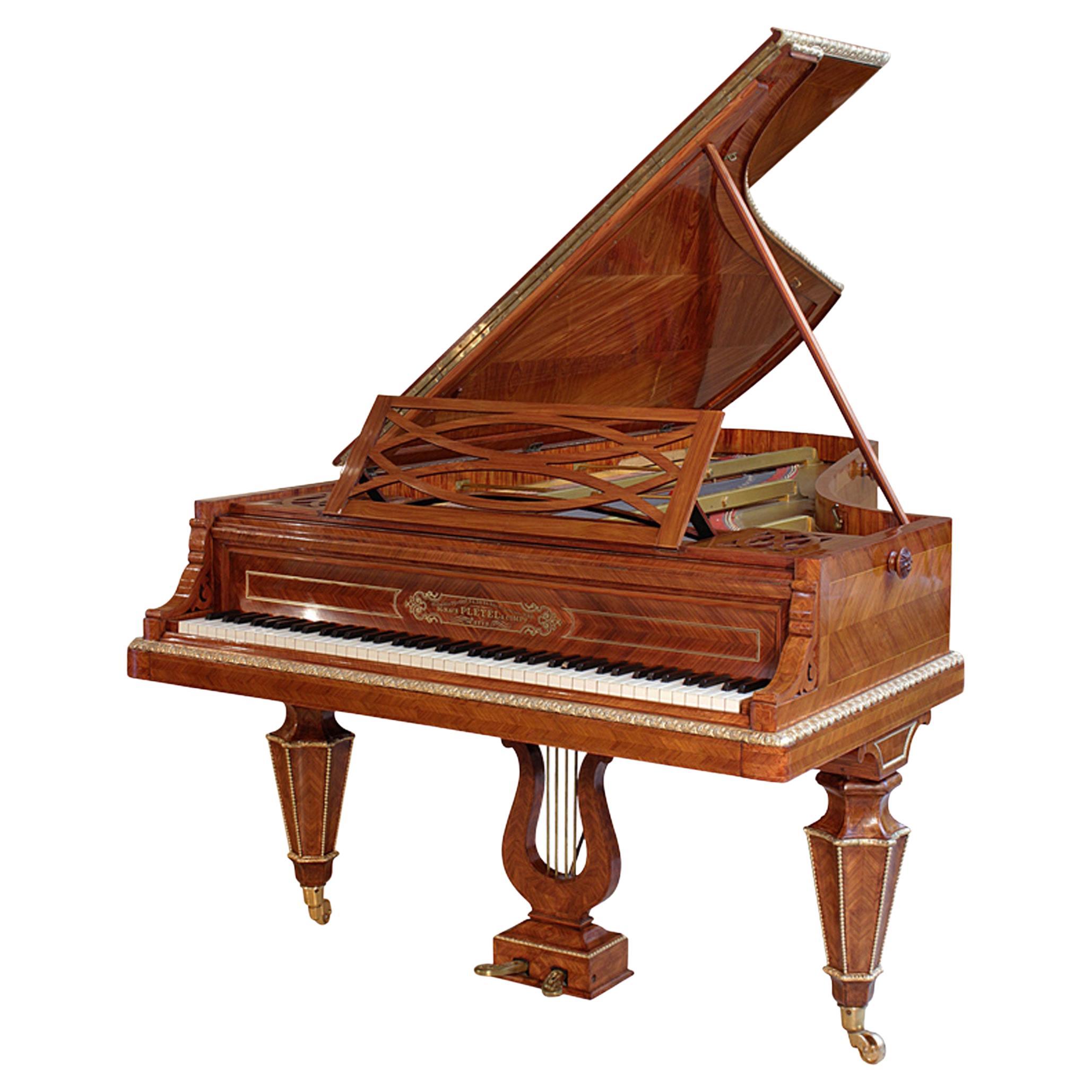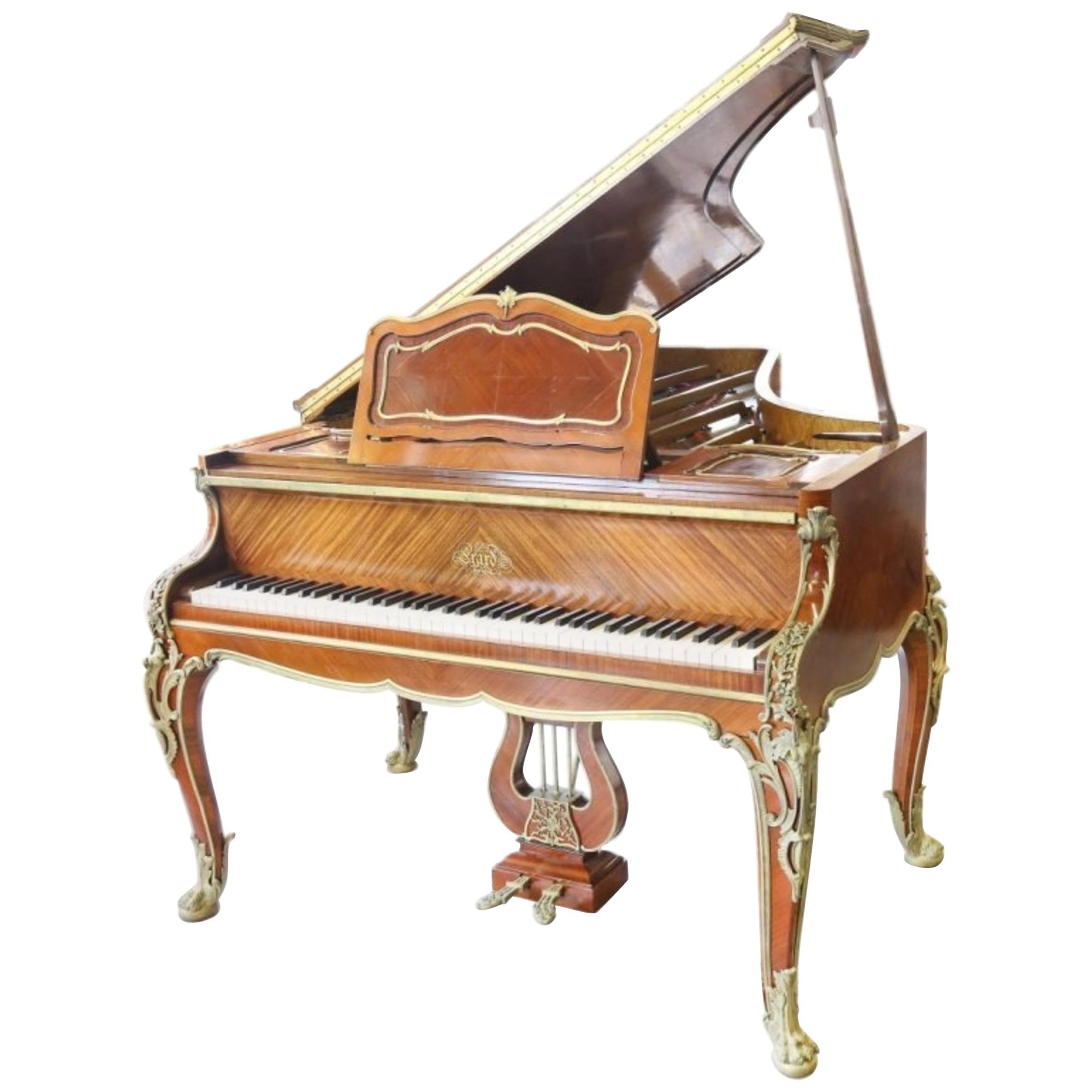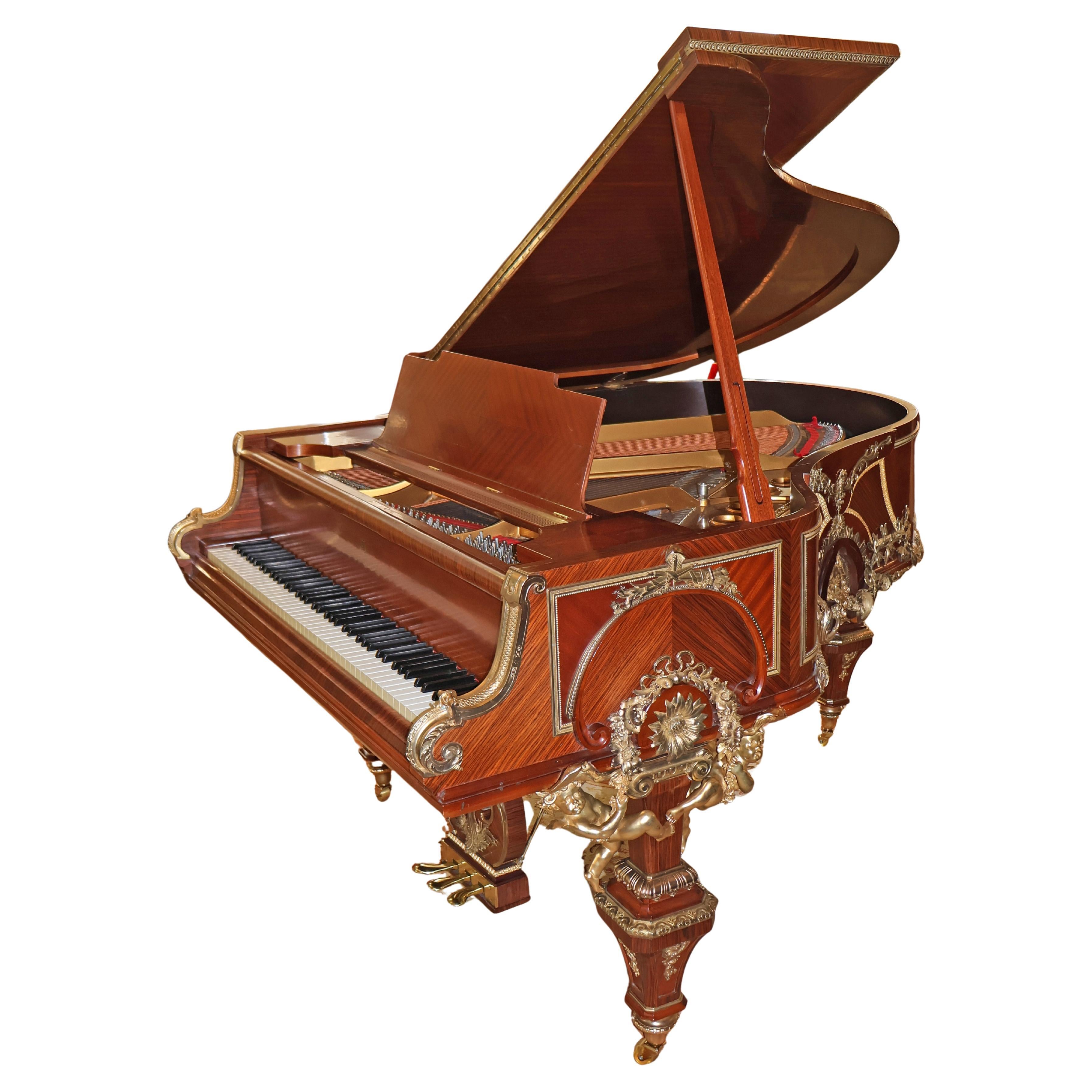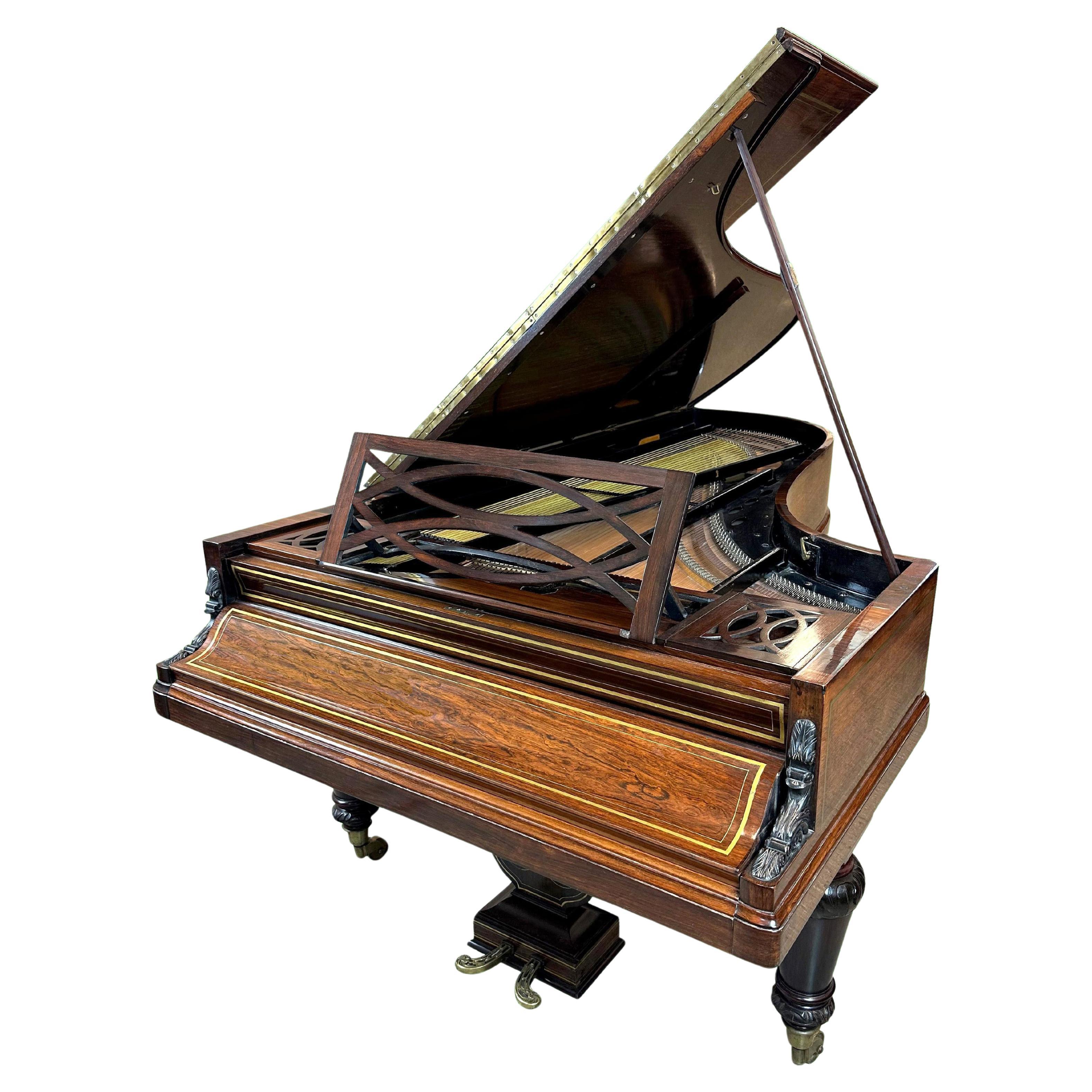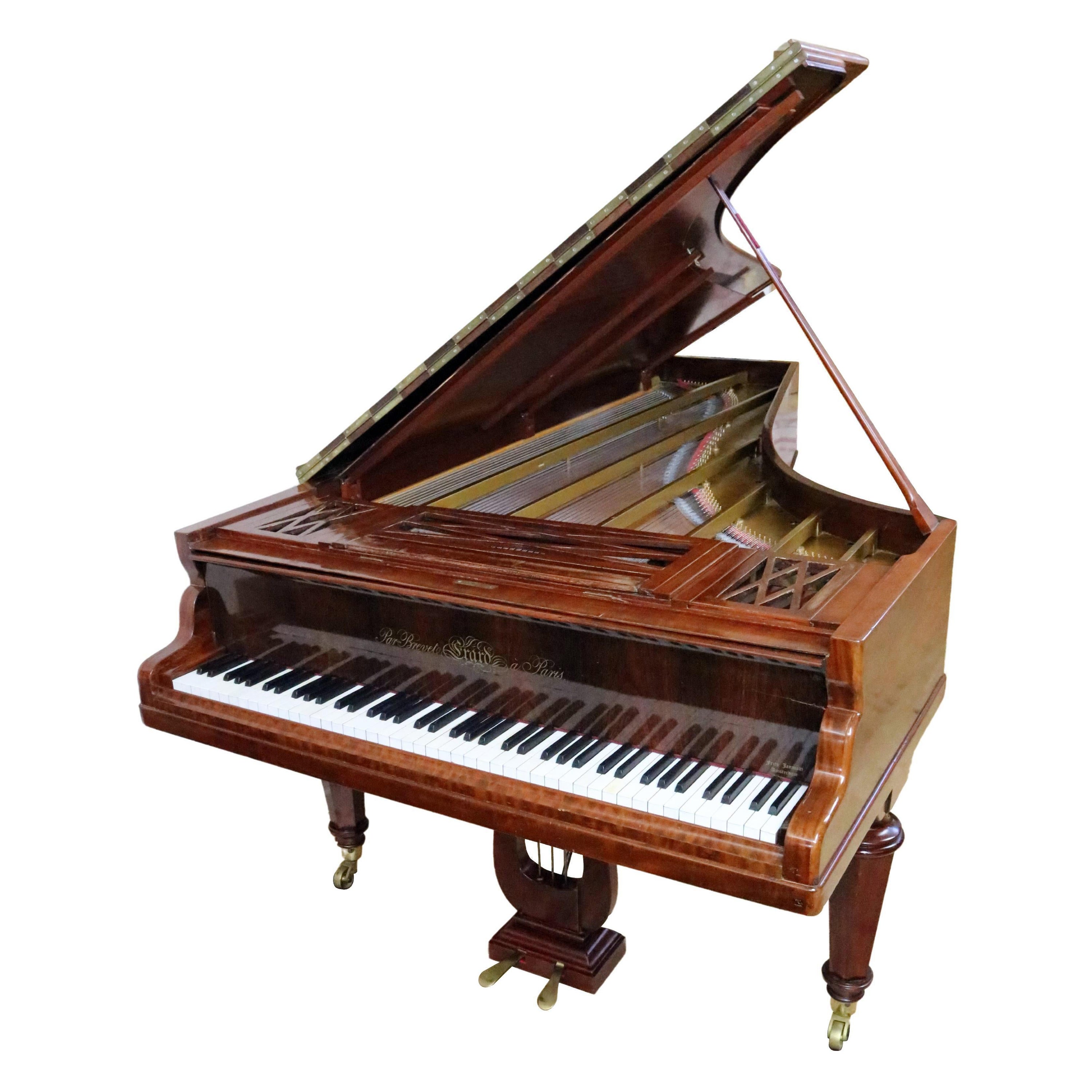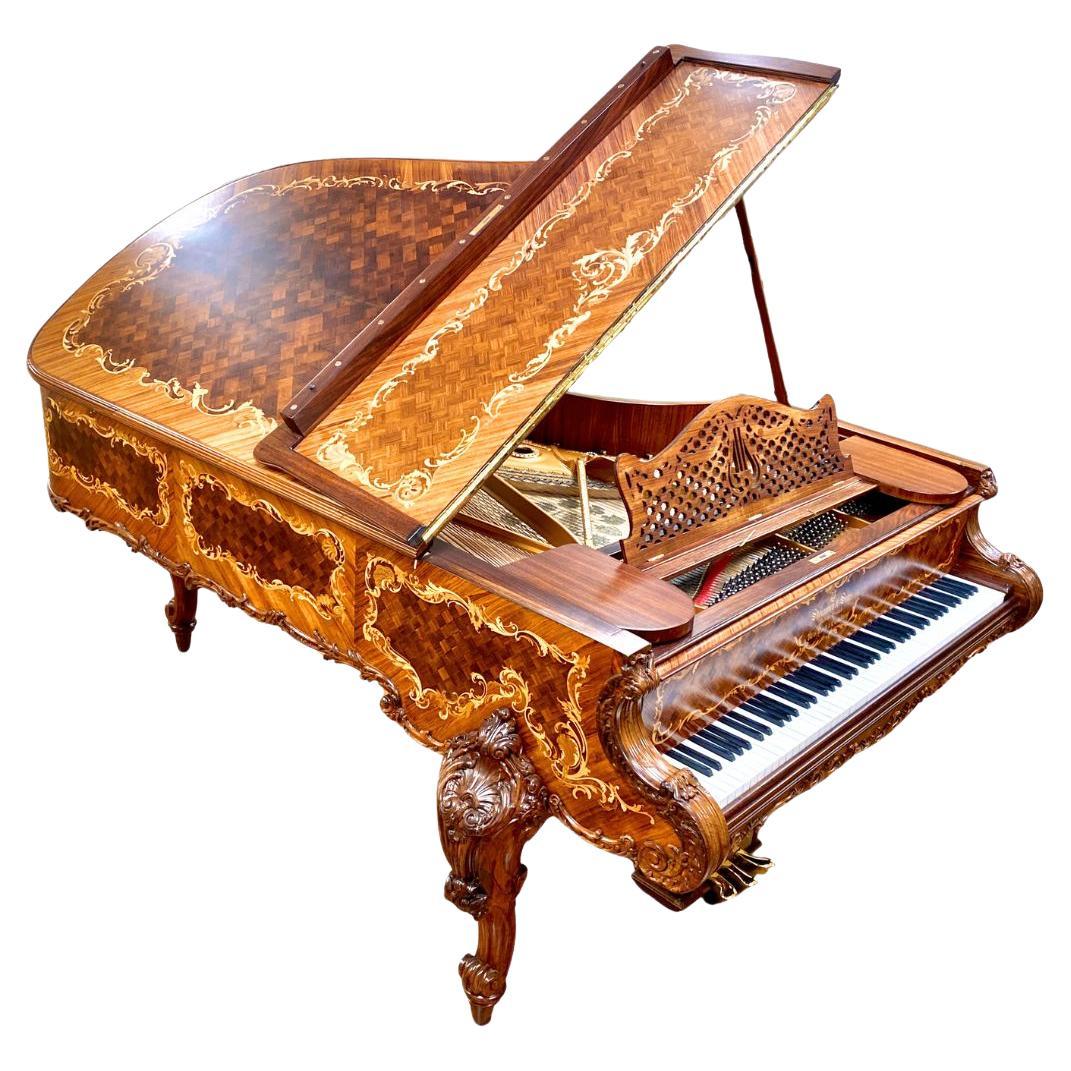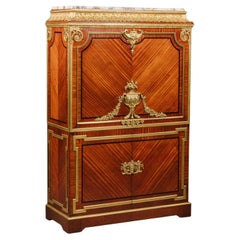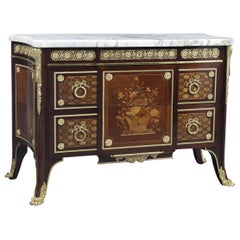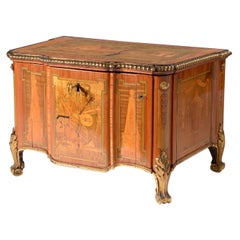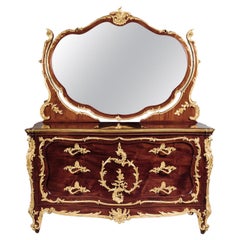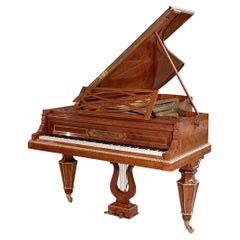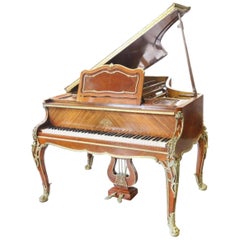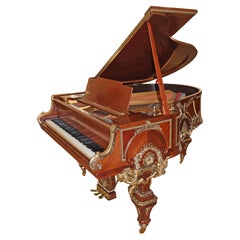Items Similar to Louis XVI Style GBaby Grand Piano by Gaveau à Paris
Want more images or videos?
Request additional images or videos from the seller
1 of 15
Louis XVI Style GBaby Grand Piano by Gaveau à Paris
$79,484.40
£58,000
€67,666.42
CA$108,873.76
A$121,091.38
CHF 63,230.16
MX$1,473,553.33
NOK 807,545.60
SEK 757,335.31
DKK 505,020.43
Shipping
Retrieving quote...The 1stDibs Promise:
Authenticity Guarantee,
Money-Back Guarantee,
24-Hour Cancellation
About the Item
A fine Louis XVI style gilt-bronze mounted baby grand Piano by Gaveau à Paris.
Serial number 67874.
This fine baby grand piano has a quarter-veneered top with a stiff leaf cast border above serpentine shaped frieze panels, centred to each side with a gilt-bronze trophy mount of a lyre and trumpets, flanked by laurel wreaths.
The fallboard is inset with the signature ‘Gaveau/Paris’; the music stand with the pierced radiating signature ‘Gaveau’ and the soundboard stamped in ink ‘Gaveau Paris’ within a cartouche illustrating medals and awards.
The piano is raised on three tapering fluted legs and with a lyre-form foot pedal, numbered "67874" and "1903/911" to the underside
French, Circa 1910.
Gaveau, established in 1847, was one of Europe's most pre-eminent piano manufacturers known for its technical innovation and quality of production.
The firm was founded in Paris by Joseph Gaveau (d. 1803) in 1847, initially from a small shop at the rue des Vinaigriers, and later the workshop and offices were transferred to the rue Servan.
Following the succession of Gaveau’s son Etienne as director of the firm, a large factory was constructed at Fontenay-sous-Bois. In 1907, a new concert hall, Salle Gaveau in the rue la Boëtie was opened, emulating the example of other leading piano-makers, in particular their great rival Pleyel, and the firm moved to offices in this street from 1908.
Bibliography:
Gaveau Co. Gaveau 1847-1947, Cent Ans Au Service De La Musique. Gaveau 1847-1947, Imprimerie Lafayette, (Paris), 1947.
Les Pianos De Concert Gaveau, Imprimerie Diéval, n.d, (Paris).
- Creator:Gaveau (Maker)
- Dimensions:Height: 39.38 in (100 cm)Width: 59.06 in (150 cm)Depth: 70.87 in (180 cm)
- Style:Louis XVI (In the Style Of)
- Materials and Techniques:
- Place of Origin:
- Period:1910-1919
- Date of Manufacture:circa 1910
- Condition:Wear consistent with age and use.
- Seller Location:Brighton, GB
- Reference Number:Seller: B754201stDibs: LU1028023008482
About the Seller
5.0
Recognized Seller
These prestigious sellers are industry leaders and represent the highest echelon for item quality and design.
Established in 1964
1stDibs seller since 2014
58 sales on 1stDibs
Typical response time: 3 hours
Associations
The British Antique Dealers' AssociationLAPADA - The Association of Arts & Antiques Dealers
- ShippingRetrieving quote...Shipping from: Brighton, United Kingdom
- Return Policy
Authenticity Guarantee
In the unlikely event there’s an issue with an item’s authenticity, contact us within 1 year for a full refund. DetailsMoney-Back Guarantee
If your item is not as described, is damaged in transit, or does not arrive, contact us within 7 days for a full refund. Details24-Hour Cancellation
You have a 24-hour grace period in which to reconsider your purchase, with no questions asked.Vetted Professional Sellers
Our world-class sellers must adhere to strict standards for service and quality, maintaining the integrity of our listings.Price-Match Guarantee
If you find that a seller listed the same item for a lower price elsewhere, we’ll match it.Trusted Global Delivery
Our best-in-class carrier network provides specialized shipping options worldwide, including custom delivery.More From This Seller
View AllLouis XVI Style Gilt-Bronze Mounted Secrétaire À Abattant
By André-Charles Boulle
Located in Brighton, West Sussex
An Impressive Louis XVI style gilt-bronze mounted secrétaire à Abattant, In The Manner Of André Charles Boulle.
This drop-front writing cabinet or secrétaire à abattant is finishe...
Category
Antique 19th Century French Louis XVI Secretaires
Materials
Ormolu
Louis XVI Style Neoclassical Commode in the Manner of Riesener, circa 1890
By Jean-Henri Riesener
Located in Brighton, West Sussex
A Fine Louis XVI Style mahogany and Marquetry Inlaid neoclassical breakfront commode in the manner of Jean-Henri Riesener.
French, circa 189...
Category
Antique Late 19th Century French Louis XVI Commodes and Chests of Drawers
Materials
Bronze
Louis XVI Serinette in the Form of a Miniature Commode by Richard, Paris, 1775
Located in Brighton, West Sussex
A very rare Louis XVI period serinette or bird organ in the form of a transitional style gilt bronze mounted and marquetry inlaid miniature commode in the manner of gilbert, by Robert Richard, Paris.
With a label for ' RICHARD - maitre facteur d’orgues et mécanicien / Rue de richelieu à la bibliothèque Du Roy / Paris 1775'.
This rare Serinette or Bird Organ has a wooden cylinder barrel mounted by twelve pins and linked to twelve sound pipes. A crank attached to the front panel controls the bellows that activates the mechanism.
The exceptional marquetry inlaid case is in the form of a gilt bronze mounted transitional style miniature commode. The top of the commode is inlaid with a landscape scene with buildings, opening to an interior with an allegory of Love Conquering All, represented by two doves perching on a bow and quiver. The front of the commode depicts two obelisks centred by a Fine musical trophy and each side is inlaid with panels depicting the Medici Vase. The back of the commode is decorated with floral marquetry.
A closely related Serinette dating from circa 1770, also in the form of a miniature commode, with the marquetry case stamped by the master marqueteur Leonard Boudin, is in the collection of the Victoria & Albert Museum, London.
The term serinette is derived from serine, French for finch. The instrument worked like a small barrel organ with a barbed cylinder, wind box and lead pipes and produced a high, thin sound in imitation of birds. Other versions included a merline, which copied blackbirds and a turlutaine, which copied curlews. Used to teach caged birds to sing tunes, different barrels could be inserted to train different birds. It first appeared in France circa 1730 and became a popular drawing-room toy for fashionable women. An interesting painting commissioned in 1751 for Louis XV by Jean-Baptiste-Siméon Chardin and now in the collection of the Louvre, depicts a refined lady seated in her salon playing a bird organ to encourage her bird to sing.
Robert Richard
Robert Richard was a Parisian organ and harpsichord maker and the mécanicien du roi to Louis XV and Louis XVI and was based in the Bibliothèque du Roi in rue de Richelieu.
Initially working alongside the Cliquot family who acted as 'facteur d'orgue du Roi', he is recorded as building an organ for the church of Notre-Dame de Quebec, in Montreal in 1753 (destroyed in 1759) and as the inventor of a mechanical concert shown in an engraving by d'Eisen in 1769.
Canon Jean Marie De La Corne described Robert Richard as : ''Le plus habile ouvrier de paris, fameux mechanitien et Homme de probité''.
French, Dated 1775.
Literature:
Pierre Kjellberg, The French Furniture of the 17th century, The Editions of the Amateur, 2008
Count Francois de Salverte, Cabinetmakers of the 18th century, Editions of Art and History, 1934
Raymond Russell, Victoria and Albert Museum Catalogue of Musical Instruments, Volume I - Keyboard Instruments,(London, 1968; p. 69.)
Elizabeth Miller...
Category
Antique Mid-18th Century French Louis XVI Musical Instruments
Materials
Wood
Louis XV Style Dressing Table Attributed to François Linke. French, circa 1910
By François Linke
Located in Brighton, West Sussex
A Louis XV style gilt bronze mounted mahogany dressing table attributed to François Linke.
Two lock plates stamped 'Ch. Leidenroth Paris ALF. Schmidt Suc'.
François Linke
...
Category
Early 20th Century French Louis XV Tables
Materials
Bronze
Fine Louis XV Style Dressing Table by Maison Giroux
By Maison Giroux
Located in Brighton, West Sussex
A fine Louis XV style gilt-bronze mounted marquetry inlaid dressing table by Maison Giroux.
The underside of the drawer with a stencil mark and paper label for 'Alphonse Giroux &...
Category
Antique 19th Century French Louis XV Vanities
Materials
Bronze
Louis XV Style Bureau Plat in the Manner of Charles Cressent, circa 1890
By Charles Cressent
Located in Brighton, West Sussex
A Louis XV style gilt-bronze mounted bureau plat in the manner of Charles Cressent.
French, circa 1890.
With one central frieze drawer and two shaped end drawers, on cabriole ...
Category
Antique Late 19th Century French Louis XV Desks and Writing Tables
Materials
Bronze
You May Also Like
French Mid-19th Century Concert Grand Piano Signed Pleyel
By Pleyel
Located in West Palm Beach, FL
A spectacular French mid-19th century, circa 1855, Louis XVI st. tulipwood parquetry and ormolu mounted, Model 2 Concert Grand Piano, signed Pleyel...
Category
Antique 19th Century French Louis XVI Musical Instruments
Materials
Ormolu
Very Fine Louis XV Style Piano by Francois Linke, Signed., Stamped by Zwiener
By François Linke
Located in West Palm Beach, FL
Francois Linke (1855-1946)
A very fine Louis XV style gilt bronze mounted kingwood piano,late 19th century , signed Francois Linke, stamped Joseph-Emmanuel Zwiener,
movement by E...
Category
Antique Late 19th Century Musical Instruments
Materials
Wood
Bronze Mounted French Case Steinway Baby Grand Piano A Model Of Francois Linke
By François Linke
Located in Long Branch, NJ
Bronze Mounted Steinway Model M Baby Grand Piano A Model Of Francois Linke
Dimensions : Height 43 in., Length 67 in., Width 56.25 in
A Gilt-Bronze Mounted Steinway & Sons Baby G...
Category
Vintage 1930s American Louis XVI Musical Instruments
Materials
Bronze
Pleyel Grand Piano, Paris 1870
By Pleyel
Located in Littleton, CO
This Pleyel concert grand piano crafted in Paris in 1870 is a timeless masterpiece that embodies the elegance and craftsmanship of 19th-century French piano manufacturing. Pleyel instruments are renowned for their exceptional quality and rich musicality, representing the pinnacle of piano design in the Romantic era, and this piano – an early example of the technological innovation of cross-stringing that was burgeoning during the period – is one in a series of only six ever produced.
This piano is in extraordinarily immaculate condition with nearly every original part, including the soundboard, pristine ivory keys, and the brass inlay in its beautifully figured walnut cabinet. Candle stands slide forward on either side of the collapsable music desk.
This piano was first purchased by the French Count Charles Étienne Gustave Le Clerc, count of Juigné (1825-1900), one of the wealthiest landowners in Brittany and a member of the French National Assembly, later a member of the House of Representatives, and in late life, the Senate.
The piano was restored in 1997 at Maison Erard by master restorationist Frits Janmaat in Amsterdam, and later conditioned by Edwin Beunk.
In recent years, some of Europe's finest historically-informed musical artists played this Pleyel in PBS concert performances in collaboration with the late Sergiu Luca.
Standing on substantial carved legs and brass wheels, the piano exudes a majestic presence through the graceful lines of its Second Empire style cabinet that embodies the period's aesthetics.
The keyboard, meticulously crafted from ivory and ebony, is a testament to the attention to detail in every aspect. Its 85 keys...
Category
Antique 17th Century French Romantic Musical Instruments
Materials
Walnut
$125,000
Erard Parallel-Strung Grand Piano, Paris, 1845
By Sébastien Érard
Located in Littleton, CO
This Erard parallel-strung grand piano, crafted in Paris in 1845 (serial number: 18725), has been extraordinarily well-tended, restored and maintained, enduring today as not only a spectacular example of the pinnacle of 19th Century piano design - characterized by its innovative construction and exceptional sonoral qualities - but also as a premium instrument by the most advanced modern standards, concert-ready for world-class, discriminating performers and their audiences.
Erard was a renowned piano manufacturer established by Sébastien Erard, and for much of the 19th Century, the company produced some of the most exquisite and innovative European pianos of the era.
The sound produced by this parallel-strung grand piano is characterized by a clarity and transparency that distinguishes it from its contemporaries. The parallel arrangement of strings contributes to a more direct transfer of sound energy, resulting in a balanced and articulate tone across the instrument's registers.
This piano's tone is beloved for its sweetness in the treble range and a robust quality in the bass, while also allowing for an especially nuanced and expressive interpretation of the musical repertoire of its era.
The ebony and ivory keyboard is a testament to the meticulous attention Erard paid to the tactile experience of playing. Each key is precision-weighted, providing a responsive touch that allows the pianist to articulate a wide range of dynamics and expressiveness.
An interior faux tableau latches to the outer case lid in an open position for maximum concert volume, and rests in a lowered position to maintain a softer, more muted experience.
The year 1845 places this Erard instrument in the heart of the Romantic era, a period marked by a surge in musical creativity and emotional expression. Composer/performers like Chopin and Liszt were drawn to Erard grand...
Category
Antique Mid-19th Century French Romantic Musical Instruments
Materials
Wood
Rare Antique 1901 Steinway Model B Rosewood Grand Piano Louis XV Rococo Restored
By Steinway & Sons
Located in Dayton, OH
Fully Restored 1901 Steinway & Sons Model B Louis XV Baroque Rococo Grand Piano – Serial Number 99151, Full 88 key keyboard.
The most exquisitely d...
Category
Early 20th Century American Louis XV Musical Instruments
Materials
Fruitwood, Rosewood
$400,000 Sale Price
20% Off
More Ways To Browse
Piano Leg
Antique French Piano
Pierce And Sons
Laurel Leaf Wreath
Antique Wood Music Stand
Antique and Vintage Pianos
Baby Foot
Trumpet Leg
Antique Baby Grand
French Grand Piano
Music Stand Lyre
Piano Babies
Baby Grand Piano
Concert Grand Piano
Ormolu Piano
Antique Piano Babies
French Louis Xvi Grand Piano
Pleyel Piano
